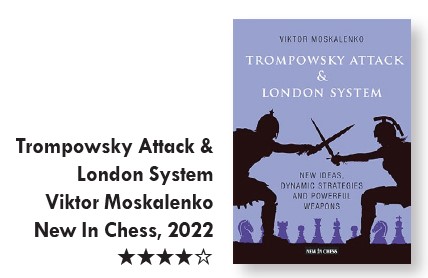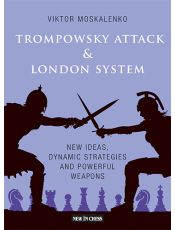Sadler on Books (2023#2)
These book reviews by Matthew Sadler were published in New In Chess magazine 2023#2
The role and influence of Steinitz is very interesting and forms a major part both of this book and the book I read as a companion to it: Willy Hendriks’ superb The Ink War (New In Chess). It was lovely to read these two books together, as many of the same characters appear in both, which gives a wonderful sense of recognition!
Hendriks’ book examines the competitive rivalry between Wilhelm (later also William) Steinitz and Johannes Zukertort in the 1870s and 1880s with their 1886 World Championship Match as the fulcrum, examining in particular Steinitz’ characterisation of their struggle as that of Modernity against Romanticism (with Steinitz on the side of Modernity of course!).
 From my point of view, I’ve come to view Steinitz through the prism of a comment I once heard Garry Kasparov make about his eternal rival Anatoly Karpov while fielding questions from members of the Clichy chess club for whom I played. At one stage Garry said ‘Do you know when Karpov played his best chess? When he was losing to me!’ The implication was that Karpov needed a real challenge to force him to display all of his talents, and that challenge could only be given by Garry. It’s obviously a rather cheeky comment, and you can question it in Karpov’s case, but when it comes to Steinitz, I might venture that Steinitz was stimulated to produce some of his deepest play in the first match he lost to Lasker and in his tournament play straight after that defeat. Before then, he was simply an extremely strong practical player with an iron will, a pronounced attacking bent and a belief in concrete play (evidenced by the odd opening variations he believed he could hold). In essence, his games are extremely strong for their time but still very much part of their time, and the openings he espoused during that period don’t have much value in the modern age.
From my point of view, I’ve come to view Steinitz through the prism of a comment I once heard Garry Kasparov make about his eternal rival Anatoly Karpov while fielding questions from members of the Clichy chess club for whom I played. At one stage Garry said ‘Do you know when Karpov played his best chess? When he was losing to me!’ The implication was that Karpov needed a real challenge to force him to display all of his talents, and that challenge could only be given by Garry. It’s obviously a rather cheeky comment, and you can question it in Karpov’s case, but when it comes to Steinitz, I might venture that Steinitz was stimulated to produce some of his deepest play in the first match he lost to Lasker and in his tournament play straight after that defeat. Before then, he was simply an extremely strong practical player with an iron will, a pronounced attacking bent and a belief in concrete play (evidenced by the odd opening variations he believed he could hold). In essence, his games are extremely strong for their time but still very much part of their time, and the openings he espoused during that period don’t have much value in the modern age.
Hendriks’ book takes us from London 1872 – the scene of Zukertort’s first meeting with Steinitz – to the conclusion of their 1886 World Championship match, taking in along the way the stormy disputes Steinitz and Zukertort fought out – many over analytical matters – through their respective British newspaper columns. Along the way we take in many different themes such as the lurking antipathy that the British chess scene harboured towards these dominant foreigners, as well as the deep-seated British tendency to venerate amateurism above professionalism. One episode that particularly resonated was Steinitz’ passionate – desperate one might say – attempts to counter the expressed view that Morphy would easily defeat him (with pawn and move odds even!) if he were to return to chess. How could you explain how much chess had progressed in those 30 years since Morphy had last played a game and how antiquated his conception of the game would be? I wonder what Steinitz would think of the fact that 120 years later, some people are still asking whether Morphy could beat everyone if he returned!
Hendriks’ comments to the chess games he examines are really good: just the right level of criticism tempered by generosity, acknowledging the excellence of certain decisions without being afraid to point out key mistakes. His annotations to the Steinitz-Zukertort 1886 World Championship match certainly brought it alive for me. In particular, I hadn’t realised that Zukertort defended against Steinitz’ Ruy Lopez with the Berlin and that Steinitz also struggled to make any headway! In the end, Steinitz switched from 1.e4 e5 2.♘f3 ♘c6 3.♗b5 ♘f6 4.0-0 ♘xe4 5.♖e1 to 4.d3 (a setup favoured by Adolf Anderssen) and ended up scoring two wins in complicated middlegames, in which Zukertort definitely had his chances.
William Steinitz - Johannes Zukertort
World Championship match United States 1886 (18)
Ruy Lopez, Berlin Variation C65
1.e4 e5 2.♘f3 ♘c6 3.♗b5 ♘f6 4.d3 d6
4...♗c5 is most played nowadays, but this is very reasonable too.
5.c3 g6 6.d4 ♗d7 7.♘bd2 ♗g7 8.dxe5 ♘xe5 9.♘xe5 dxe5 10.♕e2 0-0 11.f3 a5 12.♗d3 ♕e7 13.♘f1 ♗e6
 The players had fought out this structure in Steinitz’s previous white game and Zukertort improves his piece setup, putting the bishop to the natural e6-square rather than the passive c6-square he had previously chosen.
The players had fought out this structure in Steinitz’s previous white game and Zukertort improves his piece setup, putting the bishop to the natural e6-square rather than the passive c6-square he had previously chosen.
14.g4
Hendriks points out that if Zukertort had played like this and lost, then he would have been condemned for the ‘romantic’ chess which had been stamped out by Steinitz’s ‘modernity’. However, it was Steinitz playing White... 14.g4 certainly isn’t without point and I could certainly imagine playing it myself. However, the engines are already clearly on Black’s side. Black has holes to aim for and a lead in development to probe them!
14...♖fd8 15.h4 ♕d7
15...h5 is pointed out as a better option by Hendriks (allowing the knight to retreat to d7 after g5), although I guess Zukertort may have feared the pawn sacrifice 16.♗g5 in reply.
16.♗c2 h5 17.g5
17.♗g5 hxg4 18.h5 ♘xh5 would be a natural human reaction to White’s kingside pressure, sacrificing the exchange for a pawn, the two bishops and lots of dark squares. In any case, the King’s Indian / Dragon Defence of ...h5 against a pawn storm of the g- and h-pawns was completely unknown to Zukertort, so this was an extremely good find over the board.
17...♘e8 18.♘e3
 The commentators at the time were very much in favour of White’s position, and I have a vague recollection of reading something about this position as a child and learning that White was much better! However, as Hendriks points out, the engines see little danger on the kingside and simply want to gain space on the queenside with ...a4, ...b5, ...c6 and ...♘d6, with a clear advantage for Black. However, according to contemporary accounts, Zukertort seemed under great strain by this stage of the match and drifted terribly, unable to put together a coherent plan for the rest of the game.
The commentators at the time were very much in favour of White’s position, and I have a vague recollection of reading something about this position as a child and learning that White was much better! However, as Hendriks points out, the engines see little danger on the kingside and simply want to gain space on the queenside with ...a4, ...b5, ...c6 and ...♘d6, with a clear advantage for Black. However, according to contemporary accounts, Zukertort seemed under great strain by this stage of the match and drifted terribly, unable to put together a coherent plan for the rest of the game.
18...♕c6 19.c4 ♘d6 20.♗d3 ♖ab8 21.♘d5 ♗xd5 22.cxd5 ♕d7 23.♗d2 ♖a8 24.♖c1 c6 25.♖c5 cxd5 26.♖xd5 ♕a4 27.a3 b6 28.♗c3 ♕e8 29.♕f2 ♘c8 30.♗b5 ♕e7 31.♖xd8+ ♕xd8 32.0-0 ♘a7 33.♗c4 ♘c6 34.♗d5 ♖c8 35.f4 ♕d7 36.f5 ♘e7 37.♗a2 gxf5 38.exf5 ♗f8 39.♕f3 e4 40.♕xh5 1-0.
All-in-all these are both fantastic books, shedding light and reason on a fascinating period of development in our game. Both should definitely land on your must-read lists! 5 stars to both!
***
We round off with Trompowsky Attack & London System by Viktor Moskalenko (New In Chess). I can’t say that these openings would necessarily be ones to get my pulse racing but Moskalenko has his own unique presentation style which never fails to catch your attention in some way. PUZZLE! WEAPON! TRICK! PLAN! These words accompanied by a shaded text box liven up the narrative, alerting you to a tactic or a key idea. Moskalenko’s chess style is very inventive – he always has lots of little ideas in every type of position whatever the opening – and this presentation style dovetails very nicely with his chess style. I always discover something new when browsing through, and this game was one of them. It all looks so simple, it makes you want to try it!
 Kirill Shevchenko - Arjun Erigaisi
Kirill Shevchenko - Arjun Erigaisi
Chess.com Junior Speed 2021 (final 1)
London System D02
1.d4 ♘f6 2.♗f4 e6 3.♘f3 c5 4.e3 ♘c6 5.c3 d5 6.♘bd2 cxd4
6...♘h5 ‘WEAPON!’, says Moskalenko! 7.♗g5 f6 8.♗h4 g6 9.g4 ♘g7 10.♗g3 ♗d6 11.dxc5 ♗xc5 12.e4 with a complex struggle.
7.exd4 ♘h5
‘A modern concept but there are already 900 games with it. After removing the “London bishop” from the b8-h2 diagonal, Black will be looking for a better place for his dark-squared bishop.’
8.♗e3 ♗d6 9.♗d3
‘A solid strategy. Both these young grandmasters know how to play the London System. Moreover, this line was repeated three times in their online blitz match. The Ukrainian played the line with White and confidently showed better preparation, easily outplaying his opponent from the opening’
9.♘e5. Moskalenko also points out this WEAPON! ‘9...g6 10.g4 ♘g7 11.h4 h5 (11...♘xe5 may be a bit risky 12.dxe5 ♗xe5 13.h5) 12.♗g5 ♕b6 13.♗f6 ♖g8. This could be a very critical position. The solution for White is very concrete: 14.g5 ♘xe5 15.dxe5 ♗c5 16.♕f3 ♕xb2 17.♖b1 ♕xa2 and now 18.♗c4 with the idea 18...dxc4 (18...♕a5 19.0-0) 19.♖xb7, winning. It is clear that these analyses should be checked for both sides with great care!’
9...♘f4 10.♗xf4 ♗xf4 11.0-0 0-0 12.♖e1
 ‘Not many games were played in this position – 25 in total. White’s results are positive, mainly because he controls the centre, which allows him to play on both flanks.’
‘Not many games were played in this position – 25 in total. White’s results are positive, mainly because he controls the centre, which allows him to play on both flanks.’
12...f6 13.b4
‘In all three games of the match, Shevchenko started with this advance. 13.♕c2 WEAPON! contains a little trick: 13...g6 14.♗xg6 hxg6 15.♕xg6+. White captures the bishop on f4 with ♕h5+ and ♕g4+.’
13...♕d6 14.g3 ♗h6 15.b5 ♘e7 16.c4
‘White is clearly better.’
16...♗d7
‘16...dxc4 17.♘xc4.’
17.c5 ♕c7 18.a4 ♖ae8 19.♘b3 g6
 20.♗f1
20.♗f1
20.a5 is even stronger, according to Moskalenko. White clearly has a fantastic position and managed to put Black away in this blitz game.
20...♗g7 21.♗h3 ♘f5 22.♖c1 ♔h8 23.c6 bxc6 24.♘c5 ♗c8 25.♘d3 ♘d6 26.♖xc6 ♕d8 27.♘c5 f5 28.♘e5 ♘e4 29.♘cd3 ♗b7 30.♖c2 ♕b6 31.♘f4 g5 32.♘h5 ♗xe5 33.dxe5 f4 34.g4 d4 35.♗g2 ♘c3 36.♖xc3 ♗xg2 37.♔xg2 dxc3 38.♕d7 f3+ 39.♔g1 ♖g8 40.♘f6 1-0.
An opening book packed with tempting ideas! 4 stars!


